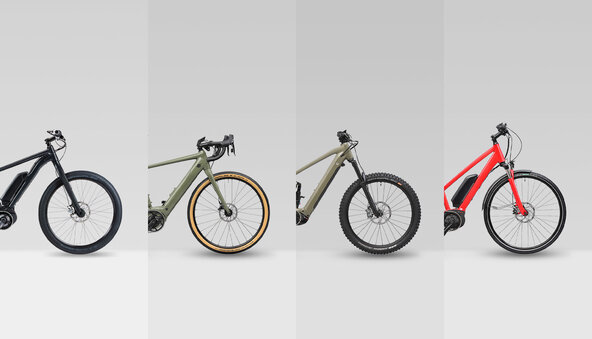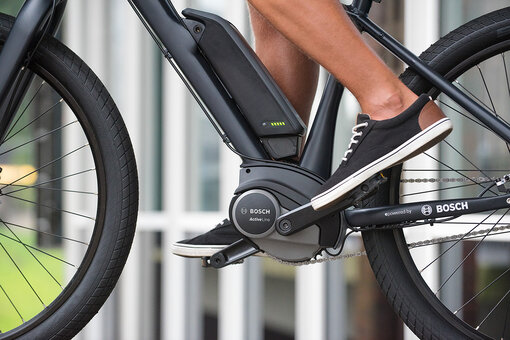Hub-Drive vs. Mid-Drive eBikes: What to Know Before Buying
By Claudia Wasko
Electric bikes – or eBikes – are one of the fastest growing categories in the cycling industry. They help riders go faster, further and longer without tiring, and buyers are turning to eBikes for everything from vehicle replacements to pure enjoyment. There are also a wide range of styles, motor sizes and price points from which riders can choose to suit their needs.
But there might also be a little confusion by some of the specs, especially when it comes to motor positioning. It’s important to know the differences between the two main types: hub-drive and mid-drive.
Hub-Drive and Mid-Drive
For a hub-drive eBike, the motor is positioned on the front or rear wheel, with the motor placed handily in the wheel hub. The motor provides propulsion by spinning the tire on which it is mounted.
Some riders find a hub motor eBike does not maneuver naturally; depending on whether the hub motor is on the front or rear wheel, the eBike either feels like it is being pushed or pulled along. That can create issues for an inexperienced rider, either because the additional weight in the back wheel makes it harder to balance, or because the additional weight in the front creates steering challenges.
For a mid-drive eBike, picture here, the motor is positioned directly in between the pedals at the bike’s bottom bracket. This ensures a low and central center of gravity, providing load balancing and creating the feeling of riding a traditional bike. Riders don’t feel the additional weight of the motor because of where it is positioned, giving a mid-drive eBike solid directional and tracking stability.
A difference riders can’t see, but will experience on a long ride – especially on hills – is that a bike with a mid-drive motor works synergistically with the bike’s gears for higher efficiency, which translates into longer riding range per charge. Like a car’s engine, electric motors like to spin fast not slow. When the rider shifts gears to pedal at a natural bike-riding cadence (typically 50-100 rpm), the motor in between the pedals is churning at an efficient rpm as well. For these reasons, Bosch uses only mid-drive motors. Learn more here.
With a hub-drive eBike, the motor drives the wheel, which can spin very slow on a steep hill. When a motor is spinning slow and the rider is requesting lots of help from the hub motor, it can sometimes overheat, leading to a temporary shut-off (best-case), or permanent damage to the magnets inside (worst-case).
Flat tires – a periodic occurrence when riding as often and far as eBikers do - is a quick fix with a mid-drive just like it would be with a regular bike; the wheels can be taken off without affecting the motor. With a hub motor, the motor is actually on the wheel itself, so even a minor hiccup like a flat tire can turn into a lengthy procedure and is not ideal for riders inexperienced with in-depth eBike maintenance. Fixing a bent or broken rim on a hub-drive eBike can be even more problematic and expensive, which requires detaching the motor from the rim and re-spoking.
To Retrofit or Not to Retrofit?
The hub-drive motor positioning causes no change to the basic design of the bike, which means a motor can be retrofitted to almost any traditional bicycle using a conversion kit with a hub motor and battery pack. While retrofits are possible with some mid-drives, most higher-quality mid-drives require a specially designed bike frame built around the motor.
Retrofitting a traditional bike with a hub motor gives flexibility to users who already own a traditional bike, and is more wallet-friendly, but it actually can negatively impact bike performance and cause safety issues. A traditional bike is not designed for motorized use, and adding a conversion kit adds weight and strain on the bike’s frame, chain, gears, and brakes which were not designed for the higher loads and speed of an eBike.
Education is Key
The eBike market has changed a lot in the last decade, when hub motors used to dominate the industry and Bosch was one of the only suppliers to offer a mid-drive. Now, the majority of North American and European bicycle manufacturers have shifted from hub-drive to mid-drives due to many of the inherent advantages described above. Over the next decade, we expect the shift from hub to mid-drive to accelerate, especially as these miracle machines get smaller, lighter, quieter, and more seamlessly integrated into the bike frame. These improvements will help eBikes, one of the world’s most sustainable transportation tools, appeal to an increasingly expanding demographic.
With an understanding of the basic differences between the motor types as well as other specifications, consumers can educate themselves on the eBike that will work best for their needs.
Claudia Wasko is General Manager of Bosch eBikes Systems Americas. Claudia can be reached at Claudia.Wasko3@us.bosch.com.



